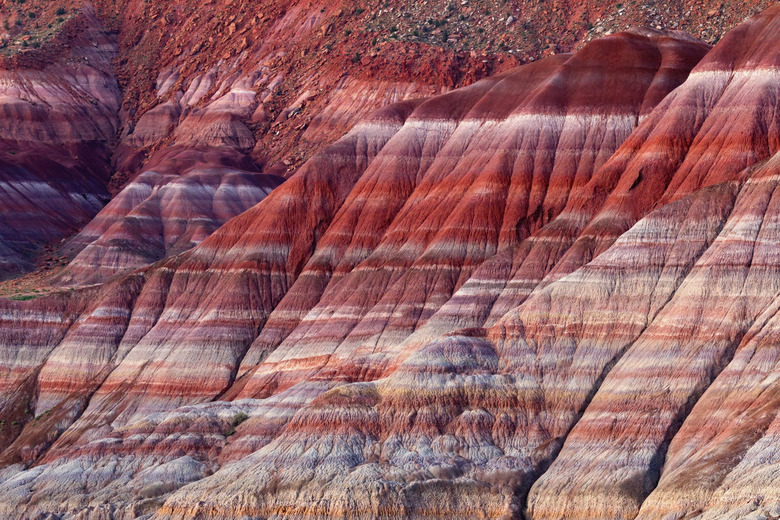Three Ways Sedimentary Rocks Are Formed
Sedimentary rocks form from the weathering of other rocks, from the remains of long-dead plants and animals, or from precipitating out of water. Their deposits form layers and beds, giving a striated look to landscape features such as mesas. Sedimentary rocks form via clastic sedimentation, chemical sedimentation or biochemical sedimentation.
TL;DR (Too Long; Didn't Read)
Sedimentary rocks, which are formed from the sediments of other rocks and materials, form via different methods. These processes include clastic sedimentation, chemical sedimentation and biochemical sedimentation.
Clastic Sedimentation
Clastic Sedimentation
Clastic sedimentary rocks are composed of solid, weathered products called clasts, which are chunks of other transported rocks. They may range in size from tiny grains to large boulders. The term lithification or diagenesis describes the process of clastic sediments converting into hard rocks. Over time as sediments become trapped, they grow compact from the weight of layered material. Grains are forced together, squeezing out excess water, and ultimately they cement together.
Examples of clastic rocks include clay, silt, sand, conglomerate rocks and sandstone. Conglomerate rocks consist of cemented round pebbles and are formed by swift rivers or ocean waves. Another example, breccia, forms from sharp pieces of rock that have not traveled as far through the elements to become smooth. When deposited sand grains cement together with crystals over time, sandstone results. Its most common primary ingredient is quartz. After settling into deep, undisturbed water such as lakes or seas, clay particles form mudstone.
Chemical Sedimentation
Chemical Sedimentation
Water moves around rocks, dissolving some of their minerals and resulting in chemical precipitation. This process describes chemical sedimentation; such rocks are named evaporites.
Halite, or common table salt, forms as a result of evaporation of lakes or seas with no outlet. Salt precipitates out of briny water into crystalline form. Gypsum represents another such evaporite. In some lakes, caves and hot springs, travertine forms from precipitated calcite. Dolostones formed from magnesium-rich fluids that altered limestone. Some non-biochemical cherts such as flint, jasper, petrified wood and agate formed from precipitated silicon dioxide.
Biochemical Sedimentation
Biochemical Sedimentation
In biochemical sedimentation, biological organisms extract ions such as calcium, potassium and magnesium into water as the organisms make shells or bones. Those hard structures remain after the organisms die, and they accumulate over time. Eventually these remains become sedimentary rock.
Some examples of biochemical sedimentary rocks include chert, coquina, biochemical limestone, diatomite and coal. Chert forms from archaic, fossilized organisms such as plankton or sponges. Coquina results from fragments of mollusks and other marine invertebrates. The calcite from wave- or current-worn animal shells accumulates into limestone, which sometimes bears fossils. Common limestone fossils include trilobites, bryozoans and oysters. Diatoms that built up and did not recrystallize formed diatomite, a lightweight white rock. Coal represents an example of biochemical sedimentation in which ancient, concentrated layers of plant matter in swamps compacted over time.
References
- USGS: What Are Sedimentary Rocks?
- Tulane University: Sediment and Sedimentary Rocks
- The Geological Society of London: The Rock Cycle – Sedimentary Rocks
- Columbia University: Sedimentary Rocks
- California State University Long Beach: Biochemical Sedimentary Rocks
- National Park Service Geology: Sedimentary
- BBC KS3 Bitesize: The Rock Cycle
Cite This Article
MLA
Hermance, Dianne. "Three Ways Sedimentary Rocks Are Formed" sciencing.com, https://www.sciencing.com/three-ways-sedimentary-rocks-formed-8215396/. 14 May 2018.
APA
Hermance, Dianne. (2018, May 14). Three Ways Sedimentary Rocks Are Formed. sciencing.com. Retrieved from https://www.sciencing.com/three-ways-sedimentary-rocks-formed-8215396/
Chicago
Hermance, Dianne. Three Ways Sedimentary Rocks Are Formed last modified August 30, 2022. https://www.sciencing.com/three-ways-sedimentary-rocks-formed-8215396/
